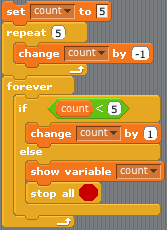Scratch, first launched in 2005, is considered one of the best languages for introducing children to programming. Some universities are beginning to introduce Scratch into introductory courses.
Scratch
 Scratch programs are flowcharts that the programmer constructs by dragging blocks around the screen. The blocks are shaped so that they click together if the "syntax" is correct. It lacks methods (functions), so it doesn't use parameters or return values, but it does have Events and Threads, both of which are important in modern computing.
Scratch programs are flowcharts that the programmer constructs by dragging blocks around the screen. The blocks are shaped so that they click together if the "syntax" is correct. It lacks methods (functions), so it doesn't use parameters or return values, but it does have Events and Threads, both of which are important in modern computing.
Extensions to Scratch exist that add functions, etc - see for example Build Your Own Blocks. Scratch 2.0 is beginning to be used - it has procedures, webcam support, Lego support and even support for cloud programming.
Harvard
Harvard tried Scratch in a "Harvard Summer School's Computer Science S-1: Great Ideas in Computer Science", the summer-time version of an introductory course at Harvard College. Details are at http://cs.harvard.edu/malan/publications/fp079-malan.pdf. They used Scratch to introduce the idea of programming and set some exercises before moving on to Java - "Though some students spent only 2 or 3 hours on their first problem set, others spent upwards of 20, implementing projects more advanced than any of those written in lecture." One student wrote "Though I did not yet know how to create a for loop, I knew when a for loop was necessary because I had used loops in my Scratch program."
Encouraged by this, the staff introduced Scratch on the full undergraduate course. CS50 is Harvard College's introductory course for majors and non-majors. Typical enrollment is 300 students. Scratch is used in the first two lectures and the first assignment; the rest of the course is taught in C, PHP, and JavaScript. Details are on http://infoscratch.media.mit.edu/SIGCSE2010WorkshopDocumention and initial Scratch code is available. See SCRATCH for Budding Computer Scientists (a tutorial).
Berkeley
In 2009 Berkerley trialed a course based on Scratch which they later introduced in an alternative introductory computing course. http://www.eecs.berkeley.edu/news/cso.pdf describes the reasoning behind the course changes, noting that
- Scratch supports some advanced (Web 2.0) ideas. It allows students to upload their finished graphical programs to the web which can then be run online in a web browser, downloaded, modified (or, "re-mixed") and re-uploaded.
- Scratch encourages broader participation - the report gives statistics on female and hispanic participation. They write that "We have a longstanding goal to provide alternative paths to prepare students for CS61a. The traditional path to CS61a, of taking the AP computer science test, suffers from little participation by populations that are typically under-represented in computer science."
Wisconsin
Their notes are at http://pages.cs.wisc.edu/~dusseau/Classes/CS202-F11/. The weekly exercises for this course are online - e.g.
- week 1 - exploring the Scratch website, playing a game and answering a survey
- week 2 - "this homework has two parts. In Part A, you'll use Scratch to draw an interesting picture. In Part B, you'll analyze different scripts written in Scratch and decide if they have the same functionality or not."
This course develops the social networking aspect. One of the first tasks the students are asked to do is upload a photo of themselves.
Rutgers
Their Programming for the Masses course uses Scratch. Though it's not a programming course, students do learn to write short programs. One development of this is the Scratchable Devices project where students can program their household devices. Using devices are equipped with an XBee module connected to Arduino microcontrollers, they can switch lights off and on by clapping, etc.
Ohio State University
In an Outreach course they offer some partly working scratch files ("Save the Turtle", etc) and invite the student to modify them. Their document is worth reading for the exercise - http://www.cse.ohio-state.edu/~paolo/outreach/ScratchSE/LabOverview.doc
Kent State University
Their introduction to computer science uses Scratch then JavaScript. Few details are online - http://www.cs.kent.edu/~volkert/10051/
Conclusions
Pros
- Reputable universities have already done a lot of the work that we'd need to do. Proposals for course-changes, Scratch tutorials and exercises for students are all online.
- Some students have an impoverished mental representation of programs - they don't "chunk". Scratch programs match my internal representation of simple programs - objects are nearly independent and have dynamic internal structure.
- Though not many Universities are officially using Scratch, the more advanced school and OutReach exercises offer sufficient challenges for students-to-be. See for example NeboMusic Polygon Robot exercise
Cons
- Scratch leads more naturally to Object-orientation, a trend that some universities have been distancing themselves from. Moreover, it segues poorly into initial C++ exercises like "get the user to type 2 numbers in. Display the sum" or "print the 5 times table"
- Scratch bypasses most of the language features that C++ students find most difficult.
- Quite a lot of the excitement of using Scratch is the social-network aspect, but this needs some management
Hi, did Berkeley ever publish follow-up data? It'd be interesting to know whether CS0 did anything to address the female and Hispanic imbalance - and also why students who took CS3 got a lower mark than those who went into CS61a directly.
ReplyDeleteSearching for related information yielded this paper on the gender imbalance in their EECS course[*] but nothing related to CS0 after the course was run.
[*]http://www.eecs.berkeley.edu/~ychen2/professional/GenderBalanceInUCBerkeleyEECS.pdf
Thanks, Graham.
I don't know any more than you, but I'll keep my eyes open - those types of imbalance concern us too.
ReplyDelete